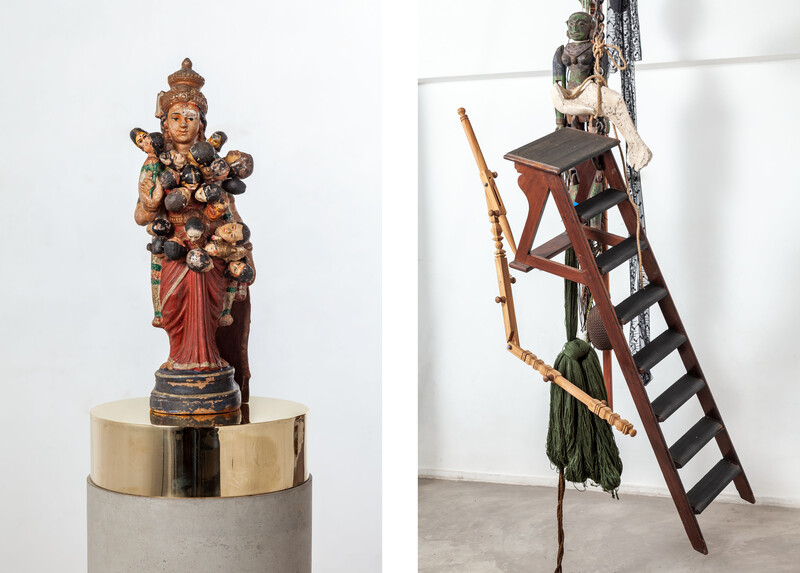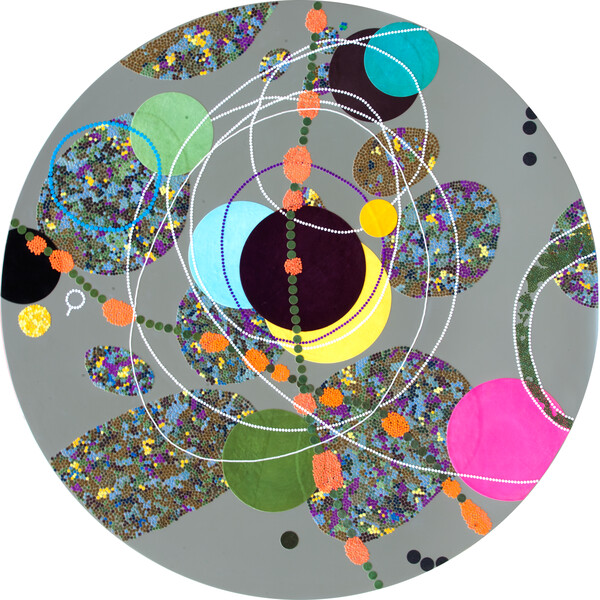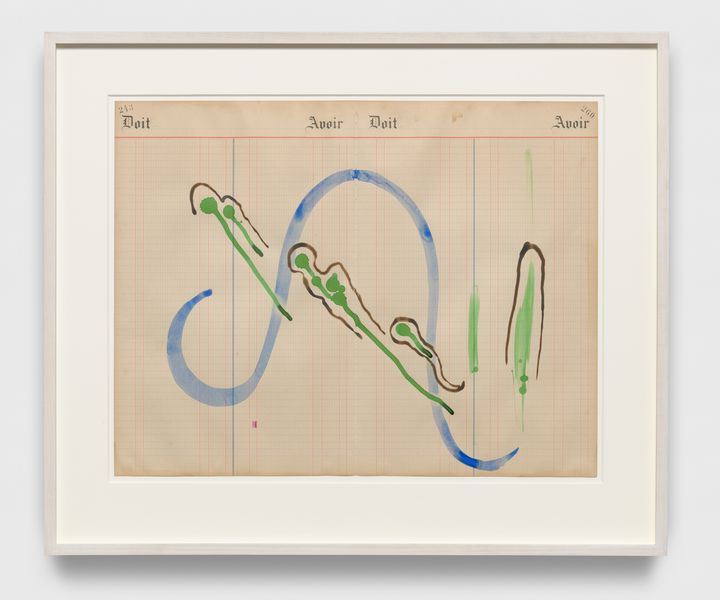Teachers’ Notes: ‘Bharti Kher. A Wonderful Anarchy’

Bharti Kher, Artemis, 2019 © Bharti Kher, Bharti Kher, A Wonderful Anarchy, 2018 © Bharti Kher
Teachers’ Notes: ‘Bharti Kher. A Wonderful Anarchy’
This resource has been produced to accompany the exhibition, ‘Bharti Kher. A Wonderful Anarchy’ at Hauser & Wirth Somerset from 28 September 2019 until 5 January 2020.
All group visits to Hauser & Wirth Somerset must be booked at least two weeks prior to arrival. Register your interest in a school booking here or contact the Education Team at education@hauserwirth.com. If you have questions or additional requests, please call our team on +44 (0) 1749 814 060.
About Bharti Kher
Bharti Kher was born in 1969 in London. She studied BA Fine Art, Painting from 1988 to 1991 at Newcastle Polytechnic. She now lives in London and New Delhi, India. She often works with found objects and is informed by her own position as an artist located between cultural, geographic and social environments. Her work encompasses painting, sculpture and installation, often incorporating found objects, for example bindis, a coloured dot worn on the centre of the forehead by women in India. Kher has exhibited at numerous museums and institutions internationally.
Recent solo exhibitions include: Museum Freider Burda, Baden Baden, Germany (2018) and Isabella Stewart Gardener Museum, Boston, MA, USA (2018). Kher’s work featured in the Sydney Biennale in 2016. Past exhibitions include Vancouver Art Gallery, Canada, (2016); Freud Museum, London, UK (2016); Lawrence Wilson Art Gallery, Perth, Australia (2016); the Rockbund Art Museum, Shanghai, China (2014); and Parasol Unit Foundation For Contemporary Art, London, UK (2012). Bharti Kher was awarded the Chevalier dans l’Ordre des Arts et des Lettres in 2015. Kher will be taking part in a forthcoming group exhibition at IMMA, Dublin, Ireland (2019).
What inspires her work?
Bharti Kher’s inspiration comes from the everyday objects that surround us; she notices how society uses objects to symbolise certain things and responds by intervening to disrupt these codes and conventions. Her work is often inspired by mythology and ancient legends, collecting and in practice, the binaries of hobbyist and artist. Her process of making and creating sculpture is centred on drawing; she says that the act of making and creating sculpture is born out of the act of drawing. She is motivated by tools for record keeping and draws with a range of such tools and media from what look like studies of biological formulas in pen to the use of a spirograph. Some of the pieces in this exhibition were conceived of during her residency at Hauser & Wirth Somerset in 2017, this includes ‘The fallow’ (2019).
What does her work look like?
When you arrive at Hauser & Wirth Somerset, you encounter the exhibition’s largest sculpture, ‘The fallow’ (2019), a monumental 3.5 metre cast bronze and painted figure that depicts an urban goddess, its appearance raises our awareness of the many ways in which we think of the female. Kher presents the power of her goddess through negative space; she is hollowed-out, becoming a product of excavation, with an ornate half-circle exploding from her depths, this formalistic intervention of shapes can be seen recurring throughout the exhibition. ‘The fallow’ is made in bronze and was cast at the Morris Singer Foundry in Hampshire. The artwork throughout the exhibition is really diverse; it is imaginative and often richly coloured. However, it is also rich in meaning, the more time you spend investigating it, the more you uncover.
‘A wonderful anarchy’ (2018) is a new balance work, bringing together some of the artist’s personal belongings, heirlooms, and found objects. Dysfunctional staircases, yarns of wool, rusted urns, and the remnants of ominous black lace are pushed up against chains, scales, horns and hooks, even the most pristine of miniature figurines. ‘Algorithm for time travel’ (2018), is one of her latest bindi panels. The bindi first appeared in her work in 1995 and is a ‘raw material’ that she used in many ways, both cartographic and psychological, and as material and motif. Kher’s finely executed bindi works create their own distinctive language. ‘The intermediaries’ (2019) are part deity (like a god) and partly secular (non-religious). They are little figurines, broken and bought together like small hybrid families, made of clay and presented on concrete and wax, displayed in such a way that we meander amongst them.

Bharti Kher, Talisman For September, 2019 © Bharti Kher
What are her main themes?
One of her main themes involves transforming found objects, through her experimentation with material and process she makes reference to layers of subjects from mythological to scientific, secular and ritualistic, physical and psychological. With much of her work, the artist is signaling a need for social change by challenging the role of women entrenched in tradition, whilst also commenting on commoditisation, for example, the use of the bindi as a fashion accessory. Through her experimental and deconstructive approach to art Kher constructs new meanings of her own. ‘Virus X’ (2019) in the Pigsty gallery is the latest in Kher’s ongoing 30-year project, beginning in 2010 and ending in 2039, that the artist describes as her entry into time and space. The Virus series involves the creation of a bindi painting each year, accompanied by an updated and pre-dated description of our predicted human encounters and observations on life. This information can be seen presented in a stack of papers, and you are invited to take a copy.
How does she make her work?
Bharti Kher works in a variety of ways; in this exhibition she presents sculpture, installation, drawings and paintings. She is concerned with experimenting with materials, this informs both her process and her subject matter. This experimentation appears to be driven by a sense of refusal to accept things as they are. Kher’s way of working is exploratory: surveying, looking, collecting, and transforming, as she repositions the viewer’s relationship with the object and initiates a dialogue between metaphysical and material pursuits.
In ‘The Intermediaries’ series, which was developed during the artist’s residency in Somerset, Kher has collected, combined, and broken disparate clay figures in order to create a selffashioned mythology. Mutating female forms come to us with heads as fruits, intertwined with lace, and bellies birthing several disembodied faces. Drawing forms a large part of Kher’s practice. ‘The whole is greater’ (2017) is a series of drawings on pages of old ledger notebooks. Kher shows a fascination with instruments of record-keeping and abstraction via shape is a recurring gesture. Kher says ‘if I could remake my artistic career, I think I would be a minimalist painter. All the art that I love comes from the tradition of reduction. When I think about the purest form, it really goes back to the intention of the object and the integrity of the object with its narrative and name’. Like her poetic use of titles for her work, Kher’s demands that we ‘read’ these drawings as much as we ‘look’ at them. Her geometric gestures across the words ‘avoir’ and ‘doit’ lend the phrase a metaphysical register that invokes the ‘space’ between owning and owing, between where one is and where one is meant to go.
How does she title her work?
The title of the exhibition and of a piece of work ‘A wonderful anarchy’ (2018) acts as a dynamic counterpoint to the outdoor bronze and the balance work in the final gallery, they bring together her vast curation of personal belongings, heirlooms, and found or collected pedestrian objects. Kher weaves this detritus of the studio in a manner so rapidly that she says the moment of making was ‘of synchronicity and rhyme’. In addition the titles of her other works make reference to her continued interest in systems, cataloguing and disruption.
Related artists: Louise Bourgeois Anthony Gormley Rebecca Horn Sarah Lucas Op Art, see Bridget Riley
–
GLOSSARY
ANARCHY
Anarchy refers to the state of a society being without authorities or a governing body, and the general confusion and chaos resulting from that condition. It may also refer to a society or group of people that totally rejects hierarchy.
ALGORYTHM
In mathematics and computer science, an algorithm is a set of instructions, typically to solve a class of problems or perform a computation. Algorithms are unambiguous specifications for performing calculation, data processing, automated reasoning, and other tasks.
BINDI
The most recognizable Indian female accessory, its name derives from bindu, meaning point or dot, and it is usually applied to the centre of the forehead. In yoga science this central point is considered to hold immense power, commonly referred to as the ‘third eye’.

Bharti Kher, Algorithm For Time Travel, 2018 © Bharti Kher
BRONZE
Bronze is an alloy consisting primarily of copper, commonly with about 12–12.5% tin and often with the addition of other metals and sometimes non-metals or metalloids such as arsenic, phosphorus or silicon. Bronze has long been used to create some of the most commonly used musical instruments and well as the majority of public sculptures.
CASTING
The act of shaping material by pouring it into a mould while molten.
DEITY
The Oxford Dictionary of English defines deity as “a god or goddess (in a polytheistic religion)”, or anything revered as divine. In the English language, a male deity is referred to as a god, while a female deity is referred to as a goddess.
INSTALLATION
Mixed-media constructions or assemblages usually designed for a specific place and for a temporary period of time. Other artists to consider: Pipilotti Rist.
SCULPTURE
A three-dimensional art made by one of the four basic processes: carving, modelling, casting and constructing.
Suggested discussion questions for your visit:
• Notice the surface texture. How has she created layers? Bharti Smith trained as a painter. How has she used this skill?
• What do you find that is surprising about her work?
• How does the sculpture change as you move? Which position do you find most interesting?
• How do you think Bharti Kher’s sculptures are best viewed? From one spot or walking around?
Suggested activities during your visit:
You will need to bring pencils and a sketchbook.
Activity 1
Split into groups of 2 -3 and select one work in the space and think of five single words to describe it. Share your words with the rest of the group; can they guess what you were looking at? See how well you have described it.
Activity 2
Negative space is the space that surrounds an object in space. Just as important as that object itself, negative space helps to define the boundaries of positive and negative space. Look through a viewfinder at the sculptures and rather than drawing them, try to draw the spaces around and in between them.
Activity 3
Find a partner and ask each other what you feel about the exhibition and how it makes you feel. Try describing a specific work to your partner and getting them to draw a response to your words. You could get them to do this blindfolded.
Activity 4
Work with someone in your group, select one sculpture to work from and fold your page in half length-wise. Imagine a line cutting a sculpture in half and make a drawing of one half on the right side of your paper. Fold the drawing behind so it cannot be seen, swap with your partner and draw in their space on the other-side. Unfold to reveal your hybrid drawing.

Bharti Kher, The Whole Is Greater 6, 2017 © Bharti Kher

Bharti Kher, The Whole Is Greater 7, 2017 © Bharti Kher
Practical activity prompts and ideas for discussion following your visit:
Bharti is well known for using colourful stick-on bindis to make her work. Can you think of a found object or logo that can be used as a symbol to represent power? Collect or copy your image or material and use repetition to produce a powerful yet decorative collage.
Key Stage 1 and 2:
• What adjectives can you think of to describe her work?
Key Stage 3:
• List other items that you think Bharti Kher might like to make sculpture from. Why do you think she would choose these materials/ objects?
• Her work is often concerned with opposites; can you make your own sculpture in this way? Think small rather than large, soft rather than hard etc.
Key Stage 4 and beyond:
• What do you know about the processes that she uses to make her work?
• What is more valuable, the process or the product?
• Is collage a 2D or 3D process?
• What are the differences between monuments and sculptures? And do you think we still need monuments?
Supplementary research: Bharti Kher ‘Bharti Kher: Matter’, Daina Augailtis, London: Black Dog Publishing, 2016 ‘Sculpture Now’, Anna Moszynska, London: Thames & Hudson, 2013
Resources
1 / 10









